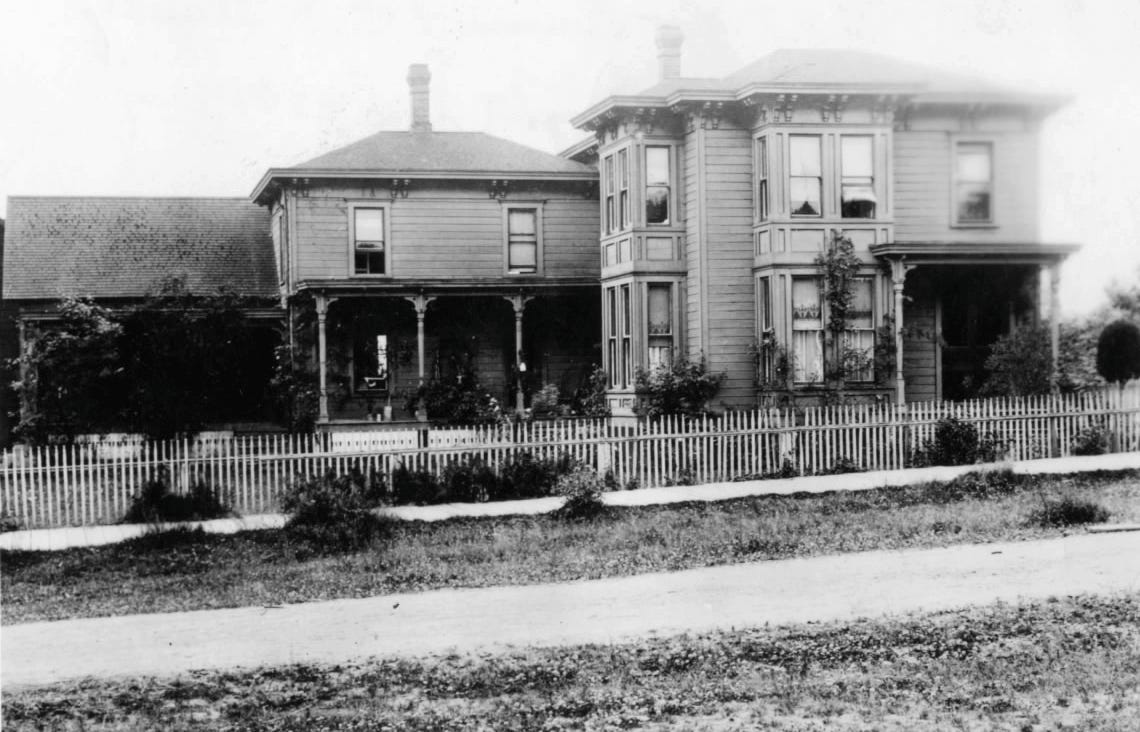Fade-in: SNOHOMISH, 1883. A True Story.
Crossfade to a young family walking single file down the wobbly gangplank from the stern-wheeler Nellie tied up at Ferguson’s Wharf, near Avenue D. It’s the humble carpenter John S. White with his young wife Delia, and their three daughters, Linnie, Elsie and Alice who is in her mother’s arms. Indians crowd in to help with their many pieces of luggage.
Pages of an ornate Victorian calendar flip through the months until it stops at July 1885 — crossfade to a dedication in the progress of the graceful, gleaming white Methodist Church, (first built on the corner of Avenue C and Third, but now located one block east on Avenue B).
The calendar pages quickly continue flipping and stop at April 1886 — crossfade to another dedication of the Odd Fellows Hall on Second Street, and again the calendar flips forward another year to April 1887 — crossfade to footage of men looking over the plans for the Getchell home (still standing at the corner of Avenue C and Second Street).
Here we meet Edgar H. Elwell, a barrel-chested lumberman from Maine who towers over White demanding that he build him an even better home than one he is doing for his business rival Joe Getchell. White builds Elwell and his wife Emma this unique Italianate-style home in 1888 — unlike anything else he built in Snohomish.
Calendar pages flip, overlaid with images of J. S. White’s buildings, stopping in 1890 with the dedication of the grand three-story brick building commissioned by the eccentric Samuel Burns, (which is still standing at 1118 First Street).
Foreboding music as the calendar pages turn slowly to the next year, 1891, crossfade to a bird’s eye view of the train crossing the river, then cut to bellowing steam from the train as it pulls into the small depot past the cemetery on the east side of town.
Through the dissipating steam, we see a small gathering of well-dressed people stop their chatter to cheer on the arrival of Nels “Pete” Hansen and his young wife Augusta. Their beaming faces and how they look at each other tells us that they are newlyweds. It’s Pete’s brother Frederick and friends who have gathered to welcome the couple and soon they are all off on a carriage ride down First Street to show the town to Pete, who is also a carpenter.
A close-up of Pete’s admiring eyes jump cuts to a reverse point-of-view shot panning down White’s gorgeous red brick Burns Block as the carriage passes by, setting the stage for our story of frontier intrigue among the builders of early Snohomish.
Time passes with a montage of the many grand homes and public buildings built by Hansen, (which like the Eagles Hall, for example, are still standing). It’s 1913. Pete is talking with his brother in front of the Elwell House when a figure from the house joins them in an animated conversation. We can only imagine what’s being said, however. It is a long shot from across the street and even our view is interrupted by a constant, back-and-forth stream of horse-drawn wagons, spurting, loud trucks, and cars — the beginning of Avenue D as we know it today.
Hansen purchases the property. A stop-action sequence of the smaller structure on the left moving away from the larger one and turning 90 degrees (to the south), a new facade is created, (in fast motion) with a large window and covered entrance porch. The sequence ends with a shot of the Hansen’s extended family gathered around the Christmas tree, opening gifts in their new home at 212 Avenue D.
Tight shot on Sunday, the 17th, as the camera backs up to reveal October 1920. Crossfade to a dolly shot passing the homes on Avenue H — they are modest homes with fading front yard gardens. The camera stops at number 310 and moves toward the front door. Inside, in the front room, daughters Linnie and Elsie are consoling each other as the camera passes them on its way up the narrow staircase. In a small bedroom, John is coming to the end of a long illness with a quiet death watched over by his wife Delia.
Epilogue: “SNOHOMISH 2013.”
Bird’s eye view of the renovated Elwell House. There is a moving truck in the alley, figures are moving the household goods of the new owner into the home with a new roof at 212 Avenue D. A title scrolls up the screen informing us that Hansens lived in this home until August’s death on Christmas Day, 1938. Pete remarried and lived seven more years, taking his reason for dividing White’s Elwell house to his grave at the G.A.R Cemetery, west of town.
The aerial shot expands to show the town alongside the river, the cemetery in the distance, and the setting sun beyond, of course.
Fade to black.
Thanks to genealogist extraordinaire Ann Tuohy for her historic fact-checking.
About the THEN photograph: One of the first homes built is Ferguson’s second addition at 214 Avenue D by popular architect /contractor J. S. White. Certainly, early Snohomish’s most unique home until it was divided by another Snohomish’s favorite builder, Nels P. Hansen in 1913. Hansen’s family of six children lived in the resulting home at 212 until the 1940s. (Courtesy Snohomish Historial Society.)
About the NOW photograph: The Elwell House was saved this year from its slow demise by Paula Denney and Cindy Taylor, fearless renovators who have brought back to life other homes on Avenue D. The photograph is by Otto Greule for a book in progress about the frontier architect, J. S. White.
Published by the Snohomish County Tribune, October 2013.




